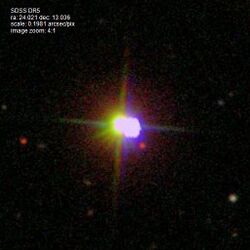Astronomy:47 Aglaja
 An image of Aglaja taken by the SDSS telescope on 13 October 1999. The minor planet was 1.7 AU from Earth at the time of photography. | |
| Discovery | |
|---|---|
| Discovered by | Robert Luther |
| Discovery date | September 15, 1857 |
| Designations | |
| (47) Aglaja | |
| Pronunciation | /əˈɡleɪ.ə/[2] |
| Named after | Aglaea |
| Aglaia[1] | |
| Minor planet category | Main belt |
| Adjectives | Aglajan |
| Orbital characteristics[3] | |
| Epoch December 31, 2006 (JD 2454100.5) | |
| |{{{apsis}}}|helion}} | 488.740 Gm (3.267 AU) |
| |{{{apsis}}}|helion}} | 372.222 Gm (2.488 AU) |
| 430.481 Gm (2.878 AU) | |
| Eccentricity | 0.135 |
| Orbital period | 1,782.960 d (4.88 a) |
| Mean anomaly | 225.007° |
| Inclination | 4.985° |
| Longitude of ascending node | 3.244° |
| 314.589° | |
| Physical characteristics | |
| Dimensions | 141.90 ± 8.72 km[4] |
| Mass | (3.25±1.68)×1018 kg[4] |
| Mean density | 2.17 ± 1.19 g/cm3[4] |
| Rotation period | 13.175[5] h |
| Geometric albedo | 0.080 [6] |
| C (Tholen) B (SMASSII)[7] | |
| Absolute magnitude (H) | 7.84 |
47 Aglaja /əˈɡleɪ.ə/ is a large, dark main belt asteroid. It was discovered by Robert Luther on 15 September 1857 from Düsseldorf.[8] The name was chosen by the Philosophical Faculty of the University of Bonn and refers to Aglaea, one of the Charites in Greek mythology.[9] It was rendered Aglaia in English sources into the early 20th century, as 'i' and 'j' are equivalent in Latin names and in the Latin rendering of Greek names.[1]
Based upon its spectrum, 47 Aglaja is listed as a C-type asteroid under the Tholen classification taxonomy, indicating a carbonaceous composition. The SMASS classification system rates it as a rare B-type asteroid. There is a broad absorption feature at 1 μm that is associated with the presence of magnetite and is what gives the asteroid its blue tint.[7]
On 16 September 1984, the star SAO 146599 was occulted by 47 Aglaja. This event was observed from 13 sites in the continental United States, allowing a cross-sectional profile to be determined. Based upon this study, the asteroid has a diameter of 136.4 ± 1.2 km. The geometric albedo calculated at the time of the occultation was 0.071 ± 0.002.[10]
2012 photometric observations of this asteroid at the Organ Mesa Observatory in Las Cruces, New Mexico gave a light curve with a period of 13.175 ± 0.002 hours and a brightness variation of 0.09 ± 0.01 in magnitude. This result is in agreement with previous studies.[5]
References
- ↑ 1.0 1.1 John Craig (1869) The Universal English Dictionary
Benjamin Smith (1903) The Century Dictionary and Cyclopedia - ↑ 'Aglaia' in Noah Webster (1884) A Practical Dictionary of the English Language
- ↑ Yeomans, Donald K., "47 Aglaja", JPL Small-Body Database Browser (NASA Jet Propulsion Laboratory), https://ssd.jpl.nasa.gov/sbdb.cgi?sstr=47, retrieved 2013-04-07.
- ↑ 4.0 4.1 4.2 Carry, B. (December 2012), "Density of asteroids", Planetary and Space Science 73: pp. 98–118, doi:10.1016/j.pss.2012.03.009, Bibcode: 2012P&SS...73...98C. See Table 1.
- ↑ 5.0 5.1 Pilcher, Frederick (October 2012), "Rotation Period Determinations for 47 Aglaja, 252 Clementina, 611 Valeria, 627 Charis, and 756 Lilliana", Minor Planet Bulletin 39: pp. 220–222, Bibcode: 2012MPBu...39..220P.
- ↑ "Asteroid Data Sets". http://www.psi.edu/pds/resource/albedo.html.
- ↑ 7.0 7.1 Yang, Bin; Jewitt, David (September 2010), "Identification of Magnetite in B-type Asteroids", The Astronomical Journal 140 (3): pp. 692–698, doi:10.1088/0004-6256/140/3/692, Bibcode: 2010AJ....140..692Y.
- ↑ "Numbered Minor Planets 1–5000", Discovery Circumstances (IAU Minor Planet center), https://www.minorplanetcenter.net/iau/lists/NumberedMPs000001.html, retrieved 2013-04-07.
- ↑ Schmadel, Lutz (2003), Dictionary of minor planet names (fifth ed.), Germany: Springer, p. 19, ISBN 3-540-00238-3, https://books.google.com/books?id=KWrB1jPCa8AC&pg=PA19, retrieved 2008-12-29.
- ↑ Millis, R. L. et al. (October 1989), "The diameter, shape, albedo, and rotation of 47 Aglaja", Icarus 81: pp. 375–385, doi:10.1016/0019-1035(89)90058-4, Bibcode: 1989Icar...81..375M. See Table 1.
External links
- This is an image of Aglaja taken by the SDSS telescope on 13 October 1999 when it was 1.7 AU from Earth/Fermats Brother
- 47 Aglaja at AstDyS-2, Asteroids—Dynamic Site
- 47 Aglaja at the JPL Small-Body Database
 |

